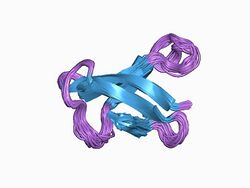Biology:Antifungal protein
From HandWiki
| Antifungal_prot | |||||||||
|---|---|---|---|---|---|---|---|---|---|
 solution structure of the antifungal protein from aspergillus giganteus. evidence for disulphide configurational isomerism | |||||||||
| Identifiers | |||||||||
| Symbol | Antifungal_prot | ||||||||
| Pfam | PF11402 | ||||||||
| InterPro | IPR022706 | ||||||||
| |||||||||
In molecular biology, proteins in the antifungal protein family consist of five antiparallel beta strands which are highly twisted creating a beta barrel stabilised by four internal disulphide bridges.[1] A cationic site adjacent to a hydrophobic stretch on the protein surface may constitute a phospholipid binding site.[1]
Human Epithelium produce antifungal proteins.[2] The proteins kill fungi by inducing apoptosis and/or forming pores on the cell membrane.[2]
References
- ↑ 1.0 1.1 "NMR solution structure of the antifungal protein from Aspergillus giganteus: evidence for cysteine pairing isomerism". Biochemistry 34 (9): 3009–21. March 1995. doi:10.1021/bi00009a032. PMID 7893713.
- ↑ 2.0 2.1 Hein, Kyaw Zaw; Takahashi, Hitoshi; Tsumori, Toshiko; Yasui, Yukihiko; Nanjoh, Yasuko; Toga, Tetsuo; Wu, Zhihong; Grötzinger, Joachim et al. (2015-10-20). "Disulphide-reduced psoriasin is a human apoptosis-inducing broad-spectrum fungicide". Proceedings of the National Academy of Sciences of the United States of America 112 (42): 13039–13044. doi:10.1073/pnas.1511197112. ISSN 1091-6490. PMID 26438863.

